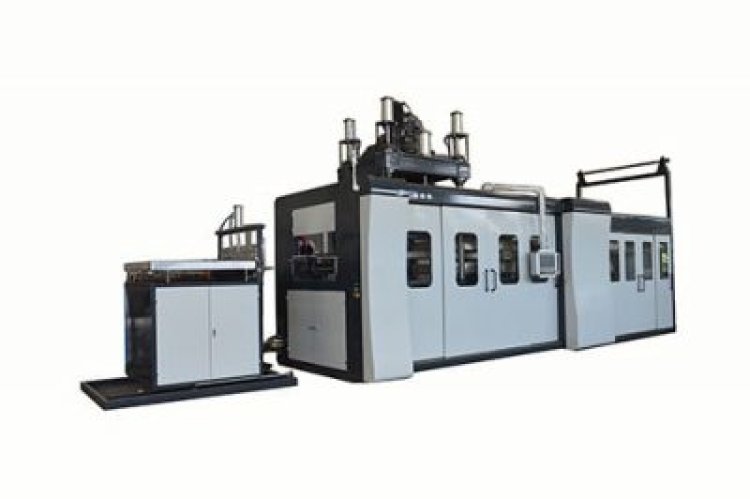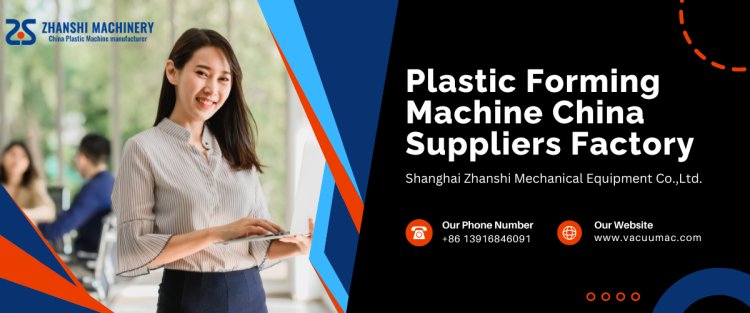Why Manufacturers Are Switching to Pressure Thermoforming Machines in 2025!
In 2025, more manufacturers are turning to pressure thermoforming machines due to their ability to deliver high-quality, detailed parts at lower tooling costs compared to traditional methods like injection molding.
Share this Post to earn Money ( Upto ₹100 per 1000 Views )

In the dynamic landscape of modern manufacturing, change is not just inevitable—it’s essential. With 2025 ushering in a wave of automation, precision engineering, and sustainability demands, manufacturers are increasingly reevaluating their production techniques. Pressure Thermoforming Machines, once considered niche, have now emerged as a game-changing technology across multiple sectors.
What Is Pressure Thermoforming?
At its core, pressure thermoforming is a manufacturing process that involves heating a plastic sheet until it's pliable, then forming it over a mold using high-pressure air. Unlike vacuum forming, which relies solely on suction, pressure thermoforming machines use compressed air to push the plastic tightly against the mold, achieving finer details and better consistency.
This process is ideal for applications requiring sharp definition, tight tolerances, and a smooth finish. It's no wonder it’s gaining popularity among manufacturers producing everything from food packaging to automotive interiors.
How Pressure Thermoforming Machines Work
Let’s break it down step-by-step:
- Heating: A plastic sheet is heated uniformly while fastened within the frame.
- Positioning: Once the sheet is pliable, the sheet is moved over the mold.
- Forming: Compressed air (up to 100 psi or more) is blown onto the surface, pressing the plastic into every nook and cranny of the mold.
- Cooling: The formed part is quickly cooled to hold its shape.
- Trimming: The finished product is made by trimming away excess material.
This approach ensures exceptional part clarity, fine details, and uniform thickness—qualities that matter in today’s high-performance product designs.
Vacuum forming is better for basic shapes and quicker turnaround, whereas pressure forming is best for intricate designs and high-quality needs.
Key Components of a Pressure Thermoforming Machine
Understanding the machinery is essential to understanding its worth:
- Heaters: Radiant panels or quartz heaters for uniform sheet warming.
- Clamping Frame: secures the plastic sheet.
- Molding Station: Includes both positive and negative molds for shaping.
- Pressure Chamber: Blows compressed air for precise forming.
- Cooling System: Rapidly solidifies the part.
- Trim Station: Cuts out the usable product.
Each component plays a vital role in delivering the precision and repeatability that pressure forming is known for.
Why 2025 Is the Tipping Point
Several trends are converging to make 2025 the year of pressure thermoforming:
- Surging demand for customized products
- Higher expectations for finish quality
- Advances in mold-making technology
- Stricter environmental regulations
Manufacturers can no longer afford to settle for low-detail, waste-heavy methods. Pressure thermoforming checks all the right boxes—speed, precision, and efficiency.
Cost-Effectiveness in High and Low Volume Production
One of the biggest misconceptions is that pressure forming is only suitable for large-scale manufacturing. That’s simply not true. Thanks to advances in mold materials and automation, it's now cost-effective even for short runs and prototyping. This gives smaller manufacturers the flexibility they need to compete with industry giants.
Precision and Detail: A Design Game-Changer
Whether you're producing car dashboards or electronic device enclosures, detail matters. With pressure thermoforming, manufacturers can achieve:
- Sharper corners
- Consistent wall thickness
- Fine textures and logos
- Complex undercuts with plug-assist tools
In 2025, design intricacy is a competitive edge, and pressure thermoforming machines deliver it flawlessly.
Energy Efficiency and Sustainability
As sustainability becomes a priority for industries worldwide, the demand for energy-efficient manufacturing methods has skyrocketed. Pressure Thermoforming Machines stand out due to their ability to minimize waste and energy consumption during the production process. Here's how:
- Reduced Material Waste: The precision of the process ensures that each part is made to exact specifications, reducing scrap and material costs.
- Lower Energy Usage: The technology has evolved to consume less power compared to traditional molding methods. This results in quicker cooling times and less dependence on heating elements, which eventually saves energy.
- Recyclability: Thermoformed products are often made from recyclable materials like PET, making the entire process more eco-friendly.
Manufacturers who adopt these machines are not only streamlining their operations but also aligning with global sustainability goals.
Versatile Applications Across Industries
Pressure thermoforming isn’t limited to one sector—its versatility is one of the reasons it’s gaining traction in 2025. Here are some industries benefiting from the transition:
Automotive Industry
The automotive sector requires precise, durable parts that can withstand high temperatures and pressure. Pressure thermoforming is perfect for making components like:
- Dashboards
- Door panels
- Bumpers
- Trims
These parts are crucial for both aesthetic appeal and vehicle performance, and pressure thermoforming ensures the highest standards are met.
Food Packaging
With increased demand for sustainable packaging solutions, pressure thermoforming has become a key player in food packaging. The process allows manufacturers to create:
- Clamshell containers
- Trays for fresh produce
- Protective blisters for products
The precision and the ability to control wall thickness make this process ideal for creating functional and eco-friendly packaging.
Consumer Electronics
From smartphone cases to TV bezels, electronics manufacturers need precise, high-quality parts. Pressure thermoforming ensures that each product not only fits the aesthetic standards but is also durable enough for daily use. Furthermore, the technique is applied to produce something:
- Lenses
- Dials
- Buttons
The fine control over material thickness and design complexity makes it an excellent choice for the electronics sector.
Material Compatibility and Waste Reduction
Another compelling reason for manufacturers to embrace pressure thermoforming is its compatibility with a wide range of materials, including:
- Polycarbonate
- Acrylic
- PVC
- PET
- ABS
This versatility allows companies to use the right material for their specific application without compromising on quality or strength. Additionally, the precision of the process results in minimal scrap, thus improving material yield and reducing waste.
Customization Without Compromise
In today’s competitive market, customization is essential. Manufacturers need to be able to create unique designs for every client, and pressure thermoforming is perfect for this. Whether it’s:
- Specially molded shapes
- Custom textures and finishes
- Complex geometries
The ability to integrate all of these features into a single product without additional steps or molds gives manufacturers the flexibility they need to stay ahead in a fast-paced market.
Shorter Lead Times and Rapid Prototyping
Speed is everything in manufacturing, and pressure thermoforming provides just that. With faster setup times compared to traditional molding methods, manufacturers can produce prototypes and low-volume runs much quicker. This not only reduces the time-to-market but also allows for quicker iterations, making it easier to meet evolving customer demands.
Common Misconceptions Debunked
Despite its advantages, some manufacturers remain hesitant to adopt pressure thermoforming due to misconceptions. Here, we address a few:
“It’s too expensive”: While the initial cost may be higher, the long-term savings from energy efficiency, reduced waste, and faster production times make it a cost-effective choice.
“It’s not suited for small runs”: Thanks to advances in machine technology, pressure thermoforming can be cost-efficient even for short production runs and prototyping.
“It can’t handle complex shapes”: On the contrary, pressure thermoforming excels at creating intricate shapes and fine details that other forming methods can’t match.
These misconceptions are slowly being debunked as more companies switch to pressure thermoforming and experience its benefits firsthand.
Why Shanghai Zhanshi Leads the Market
Shanghai Zhanshi Mechanical Equipment Co., Ltd., a pioneer in the development of cutting-edge solutions that are created to meet the needs of modern manufacturers, has established itself as a leader in this field. Their computers are equipped with the most recent amenities, such as:
- High-precision forming technology
- Automated process control for consistency
- Customization options for specific industries
- Energy-efficient designs
With an unwavering commitment to quality, Shanghai Zhanshi ensures that their customers have the tools they need to stay competitive in 2025 and beyond.
Is Pressure Thermoforming Right for You?
The transition to pressure thermoforming machines can be a significant decision for any manufacturer. If your production process demands high-precision parts, faster lead times, and versatility in materials, then adopting this technology could be the key to future-proofing your operations. However, it's crucial to consider factors like this:
- Production volume
- Design complexity
- Material requirements
- Budget for equipment
Once these are evaluated, manufacturers can determine whether pressure thermoforming is the right fit for their business.
Future Trends: What’s Next for Technology?
As we look toward the future, pressure thermoforming is expected to evolve further. Key trends include:
- Smart Thermoforming: The integration of IoT and machine learning to monitor and optimize the forming process in real time.
- Automation: More automated systems will be developed to streamline production and reduce human error.
- Sustainability: New materials and processes will emerge to make pressure thermoforming even more eco-friendly, reducing waste and energy consumption.
- Advanced Molds: With 3D printing technologies advancing, manufacturers will be able to create more complex and cost-effective molds for pressure forming.
These innovations will make the technology even more accessible, efficient, and sustainable for manufacturers worldwide.
In 2025, the pressure thermoforming machine stands as a powerful tool that manufacturers cannot afford to overlook. It offers unparalleled benefits, making it the go-to choice for all industries, from energy efficiency to design flexibility. Shanghai Zhanshi Mechanical Equipment Co., Ltd. is at the forefront of innovation and technology, helping businesses stay ahead as production demands change.
By understanding the advantages and applications of pressure thermoforming, manufacturers can make an informed decision that will not only enhance their production processes but also help them achieve long-term success.
FAQs
What is the difference between pressure thermoforming and vacuum forming?
Pressure thermoforming uses compressed air to force plastic into a mold, resulting in sharper details and better wall thickness control, while vacuum forming relies on suction alone.
Is pressure thermoforming suitable for both low and high-volume production?
Yes, pressure thermoforming is cost-effective for both low-volume runs and high-volume production, offering flexibility for manufacturers of all sizes.
What kinds of materials are suitable for pressure thermoforming?
Pressure thermoforming can be used with a variety of materials, including polycarbonate, PVC, acrylic, PET, and ABS, depending on the product requirements.
Can pressure thermoforming be used for creating complex designs?
Absolutely! Pressure thermoforming is ideal for creating intricate designs, fine textures, and parts with precise undercuts.
What are the environmental benefits of pressure thermoforming?
Pressure thermoforming reduces material waste, offers energy-efficient production processes, and can use recyclable materials, making it an eco-friendly choice.

 plasticformingmachine
plasticformingmachine 















